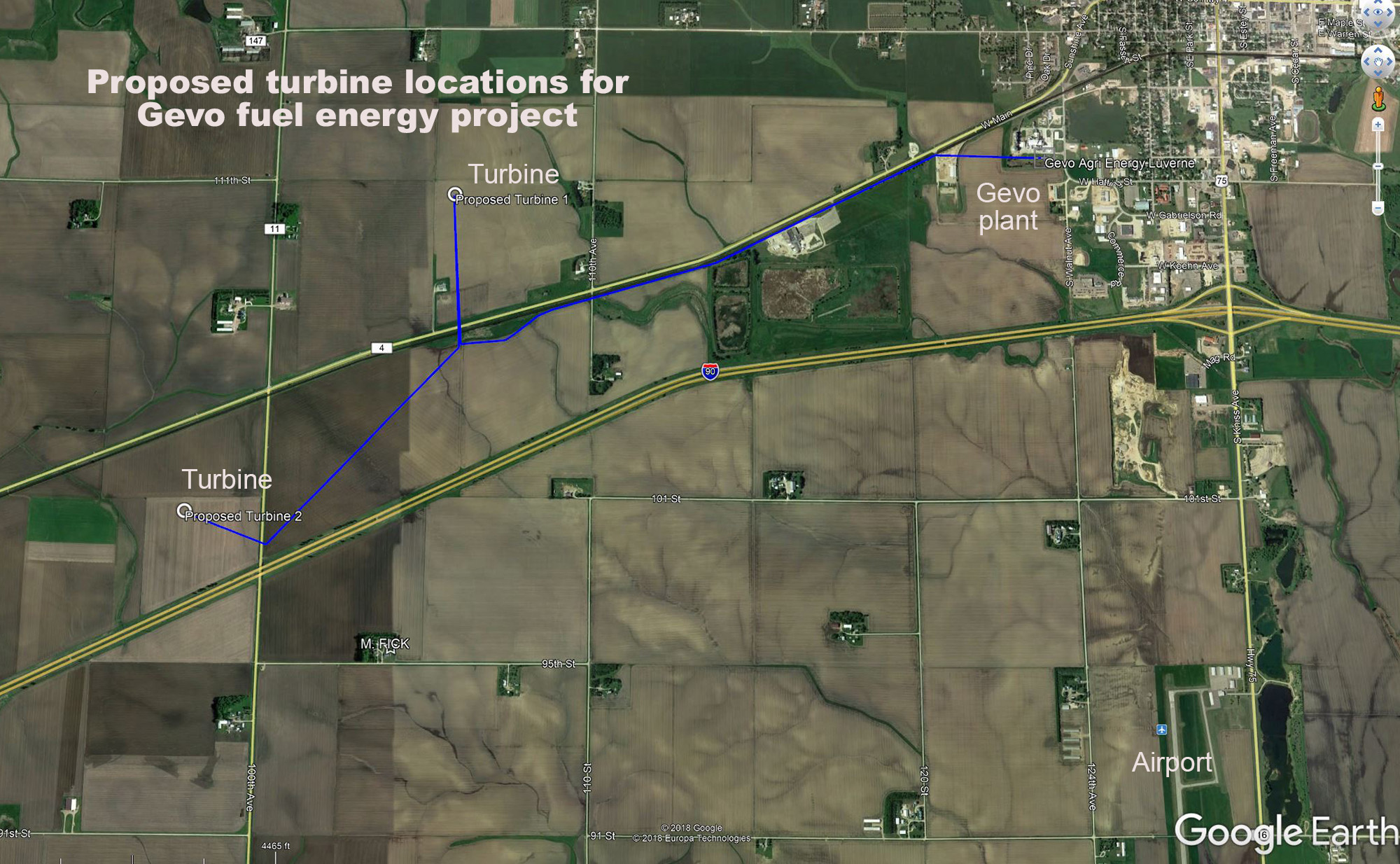
The Rock County Board of Adjustment granted two property line setback easements to Gevo Inc. of Luverne for its wind fuel project after a July 1 public hearing.
The project involves construction of two 2.4-megawatt wind turbines about 2 1/2 miles west of the Luverne renewable energy production plant.
Twenty people attended the hearing where project partner Juhl Energy Development of Chanhassen requested the turbines to be built closer to neighboring property lines than the county ordinance allows. The project meets all other setback requirements.
The ordinance stipulates that turbines must be three times the rotor diameter east-west and five times the diameter north and south from a neighboring property.
The proposed turbines are 450 feet from the blade tip to the ground.
“In order to achieve that (setback) we need to have a parcel three-quarters of a mile to a half mile (from the neighboring property line),” said Aaron Thibert with Juhl Energy. “There aren’t a lot of these (parcels) that remain out there.”
The proposed turbines would be located in sections 17 and 19 of Luverne Township.
The turbines would provide electrical power directly to the plant, reducing the plant’s reliance on power generated by carbon-based sources.
Concerns raised at the hearing included loss of property owner rights and health concerns from noise and shadow flickers from the operating turbines.
“Obviously we are going to lose some rights, some wind rights,” said neighboring property owner Brett Stegenga.
“(If) I want to build a house across the property line from the wind tower, I am going to lose that right.”
Assistant county attorney Don Klosterbuer said before any variance is granted, officials answer seven questions to determine if certain conditions exist.
Existence of any of those conditions would cause the board to decline the variance.
“One of the questions is ‘who was there first,’” he said.
“The fact that someone says they might want to do this at some point in time in the future … does that unfairly or unreasonably prohibit a person who may want to make the development? You’ve got to balance those tests out.”
The loss of some of those rights, such as wind rights, could require compensating the landowner for the loss.
Mike Powers with Juhl Energy said because the variance would allow turbines to be located closer to neighboring property lines than the ordinance permits, a neighbor’s ability to erect additional turbines could be inhibited.
“It (the turbine) slows down the wind as it converts that wind to energy,” Powers said. “It would limit the neighbor’s ability to put a turbine within that 1,200 feet or so behind the wind stream of the turbine we would be erecting.”
Neighbors Brad Ver Steeg and Sarah VanNieuwenhuizen questioned the noise and shadow flickers from the operating turbines.
“I am just interested in the health effects and the noise that is during the night,” VanNieuwenhuizen asked. “Does this disturb your sleep?”
Thibert said computer software was used to generate data based on various conditions and at different locations. The software also calculated effects at different times of the day and year.
The county ordinance follows the state requirements that an operating turbine cannot exceed 50 decimals at night and 60 decimals during the day.
“Worst-case scenario were decimals between 30 and 40 at the nearest dwelling,” Thibert said.
Adjustment Board member Gawaine Diekevers spoke from personal experience. He lives close to the turbines located in Martin Township where the first such structures were built in the county.
“We’ve been living there 15 years and it doesn’t bother us anymore,” he said.
“The only time I really hear them is during a 20-mph northwest wind blowing to the southeast coming right over my place. It is kind of a whosh-whosh noise. I can’t say we ever hear it in the house.”
Cattle are also not bothered by the turbines.
“Once they get used to it, they don’t pay attention to it either,” Diekevers said.
The approved variances allow the Gevo wind energy project to move forward to apply for a conditional use permit.
“In the process, there are at least two more board hurdles that need to be dealt with before you see a tower go up,” Klosterbuer said.


